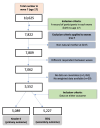Does cumulative adverse socioeconomic exposure mediate the association of maternal mental ill health at birth and adolescent mental ill health at age 17? An analysis of the Millennium Cohort Study
- PMID: 37280065
- PMCID: PMC7618127
- DOI: 10.1136/jech-2022-220248
Does cumulative adverse socioeconomic exposure mediate the association of maternal mental ill health at birth and adolescent mental ill health at age 17? An analysis of the Millennium Cohort Study
Abstract
Background: Adolescent mental health is a public health priority. Maternal mental ill health and adverse socioeconomic exposure (ASE) are known risk factors of adolescent mental ill health. However, little is known about the extent to which cumulative ASE over the life course mediates the maternal-adolescent mental health association, which this study aims to explore.
Methods: We analysed data from more than 5000 children across seven waves of the UK Millennium Cohort Study. Adolescent mental ill health was measured using the Kessler 6 (K6) and Strengths and Difficulties Questionnaire (SDQ) at age 17. The exposure was maternal mental ill health as measured by the Malaise Inventory at the child's birth. Mediators were three measures of cumulative ASE defined by maternal employment, housing tenure and household poverty. Confounders measured at 9 months were also adjusted for, these were: maternal age, maternal ethnicity, household poverty, maternal employment, housing tenure, maternal complications during labour and maternal education. Using causal mediation analysis, we assessed the cumulative impact of ASE on the maternal-adolescent mental ill health relationship between birth and age 17.
Results: The study found a crude association between mothers' mental health at the child's birth and mental health of their children at age 17, however, when adjusting for confounders this association was reduced and no longer significant. We did not find an association between cumulative exposure to maternal non-employment or unstable housing over the child's life course and adolescent mental health, however, cumulative poverty was associated with adolescent mental ill health (K6: 1.15 (1.04, 1.26), SDQ: 1.16 (1.05, 1.27)). Including the cumulative ASE measures as mediators reduced the association between maternal and adolescent mental health, but only by a small amount.
Conclusions: We find little evidence of a mediation effect from cumulative ASE measures. Experiencing cumulative poverty between the ages of 3-14 was associated with an increased risk of adolescent mental ill health at age 17, suggesting actions alleviating poverty during childhood may reduce adolescent mental health problems.
Keywords: adolescent; maternal health; mental health; poverty; social class.
© Author(s) (or their employer(s)) 2023. No commercial re-use. See rights and permissions. Published by BMJ.
Conflict of interest statement
Competing interests: None declared.
Figures



References
-
- Early Intervention Foundation. Adolescent mental health evidence brief 1: Prevalence of disorders. 2020
-
- Barr B, Taylor-Robinson D, Stuckler D, Loopstra R, Reeves A, Wickham S, et al. Fit-for-work or fit-for-unemployment? Does the reassessment of disability benefit claimants using a tougher work capability assessment help people into work? Journal of Epidemiology and Community Health. 2016 May 1;70(5):452–8. - PubMed
-
- Hope S, Pearce A, Chittleborough C, Deighton J, Maika A, Micali N, et al. Temporal effects of maternal psychological distress on child mental health problems at ages 3, 5, 7 and 11: Analysis from the UK Millennium Cohort Study. Psychological Medicine. 2019 Mar 1;49(4):664–74. doi: 10.1017/S0033291718001368. - DOI - PMC - PubMed
-
- Butler AC. Poverty and Adolescent Depressive Symptoms. American Journal of Orthopsychiatry. 2014;84(1):82–94. - PubMed
-
- World Health Organisation. Adolescent mental health. 2020. [cited 2020 Nov 6]. [Internet] Available from: https://www.who.int/news-room/fact-sheets/detail/adolescent-mental-health.
Publication types
MeSH terms
Grants and funding
LinkOut - more resources
Full Text Sources
Medical
